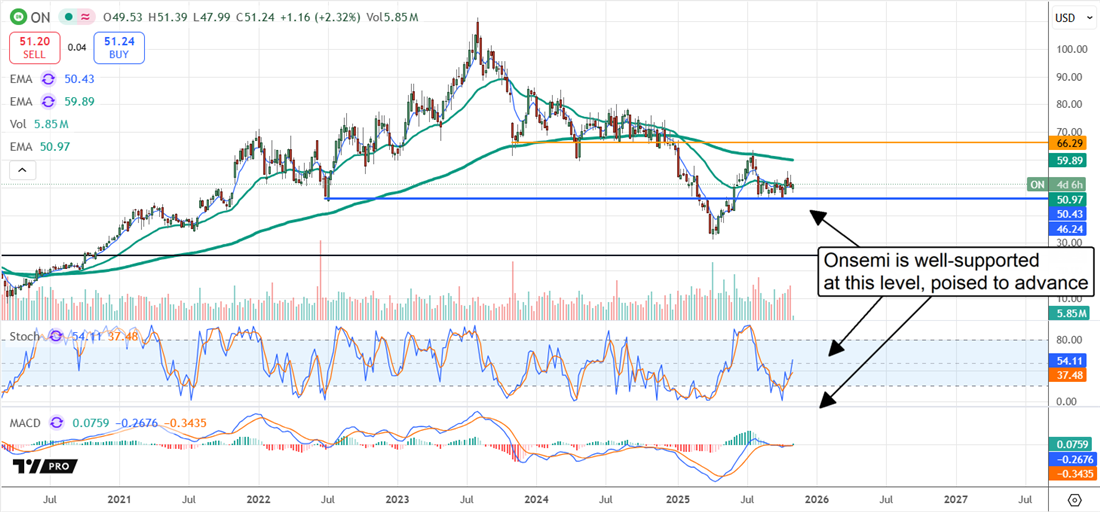Semiconductor Supercycle: Why Onsemi Stock Could Double as AI and EV Growth Accelerate
![]()
Onsemi (NASDAQ: ON) is on track for a semiconductor supercycle that could add 100% to its share price over the next few quarters.
The company’s semiconductor products are well-suited to a range of end markets that rely heavily on power consumption and are in increasing demand, driven by the growing adoption of AI. The industrial, autonomous vehicles, cloud, 5G, and IoT markets are in an upcycle that may last for years, if not a decade or more, as technology advances, AI adoption increases, and societal penetration grows.
The critical takeaway is that the Q3 results and guidance affirm that this business will inflect to year-over-year (YOY) growth in 2026, widen its margins, and drive significant shareholder value for the year and long into the future.
One of Onsemi’s unique qualities is its cash flow and capital return. The company’s balance sheet is a fortress, and operational quality is high, allowing for significant free cash, most (if not all) of which is used for capital return. Onsemi doesn’t pay dividends but aggressively reduces its share count and will likely continue to do so.
As it stands, the Q3 activity reduced the count by 1.65% for the quarter, 4.5% year-to-date, and 5.5% compared to the same period last year, representing a significant gain. The only bad news is that equity is diminished, but the treasury shares offset it, increasing faster than equity was lost, leaving shareholders ahead.
2026 Growth Outlook: Guidance Confirms a Turnaround Is Near
Onsemi continues to face headwinds, with Q3 revenue down year-over-year due to weakness across all segments. However, all segments grew at a mid-to-moderate single-digit pace sequentially, revealing increasing momentum in end markets, and contributed to outperformance. Revenue topped MarketBeat’s reported consensus by approximately 200 basis points, and the strength carried through to the bottom line.
Margin is another area of strength for investors to focus on. The company’s operational quality is impaired compared to the prior year, primarily due to revenue deleverage; however, it is improving sequentially along with demand.
The net result is that adjusted EPS came in four cents ahead of consensus of 63 cents, and guidance aligned with the consensus—a notable achievement given the revision trends. The outlook for Q4 and the upcoming quarters is at long-term lows as of early November.
Institutional and Analyst Trends Suggest a 15%+ Upside
Analyst activity was mixed leading into the Q3 release, but reveals conviction firming around the $57 consensus price target.
It forecasts a 15% upside as of the pre-release close and will likely trend higher in upcoming quarters.
Until then, analyst support is significant and increasing, as reflected in expanded coverage and institutional activity.
Institutions provide a solid support base, owning approximately 98% of the stock, and they have been buying it. The group sold heavily in Q1, which exacerbated the share-price downdraft in the quarter, and then reverted to buying in Q2, sustaining the trend through the first month of Q4.
Onsemi’s Market is Poised for a Sustained Capital Inflow
Onsemi’s stock chart reflects the analyst and institutional activity, showing a bottom in Q1 and a rebound in Q2. The setup in early November is a market that has pulled back from its rebound highs, revealing support at a higher level and a high potential to advance, potentially with strength.
 Indications that this market is poised for advancement include elevated average daily volume, the steady increase in trading volume leading up to the report, and the MACD and stochastic indicators. The indicators suggest that this market is at its bottom, calmly awaiting the signal to advance.
Indications that this market is poised for advancement include elevated average daily volume, the steady increase in trading volume leading up to the report, and the MACD and stochastic indicators. The indicators suggest that this market is at its bottom, calmly awaiting the signal to advance.
The critical support target is near $46.50 and is unlikely to be broken; the critical resistance targets are near $61 and $66.50, both of which may be tested before the end of the year. A move above $66.50, however, may not be possible until the subsequent earnings, when guidance for 2026 is revealed.
Learn more about ON
![The Best Local Butchers for Thanksgiving [2025 Survey]](https://www.marketbeat.com/logos/articles/med_20251103152959_the-best-local-butchers-for-thanksgiving-2025-surv.png)


